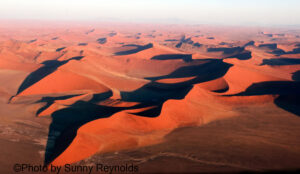
An aerial view of Sossusvlei
Namibia is a land of deserts, with the red dunes of the Kalahari to the east and vast Namib Sand Sea along the western coast. It is a land of savannahs, with the iconic camelthorn trees sustaining giraffes, elephants, birds, and many varieties of antelope roaming the dry plains. There are several national parks and designated conservation areas to protect the diverse wildlife in Namibia. Here is a quick look at the ones we visit.
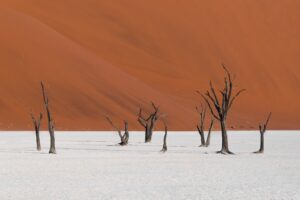
Deadvlei
Our adventure includes a visit to the Namib Desert, where you will find the Namib-Naukluft National Park. The two most notable sights in the park are Sossusvlei and Deadvlei, where some of the most iconic images of the country are often taken. Sossusvlei, meaning the “dead-end marsh,” is a salt clay pan surrounded by some of the tallest sand dunes in the world. At the foot of “Big Daddy Dune” lies Deadvlei (meaning “dead marsh”). You have no doubt seen the haunting photos of the long-dead trees set against the backdrop of the towering dunes. These camelthorn trees are estimated to have died 600 – 900 years ago, their skeletons burnt by the sun and preserved by the dry climate. In the morning, the rising sun casts long shadows of these skeletons while lighting up the sand dunes behind them. The feeling you get when walking through Deadvlei is akin to entering an ancient church graveyard – one of reverence and contemplation. It is humbling to stand among the living relics of trees that have stopped living centuries ago.
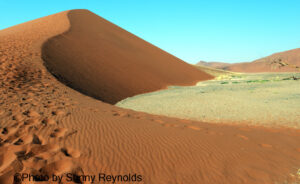
Dune 45
While the desert may seem lifeless, it is anything but. If you look closer, you will encounter some of the most unique flora and fauna that has adapted to the harsh unforgiving conditions of the desert. Nara Melons are a common sight in Sossusvlei and are valuable sustenance for the springbok, oryx, and ostriches. The Welwitschia plant is like no other, drawing water from fog and living anywhere from 400 – 1,500 years. The oldest is believed to be 2,000 years old.
And then there’s the mysterious “fairy circles” – empty, perfectly round patches of sand surrounded by grasses. The origin of these circles has been hotly contested, but the most likely explanations are that they are formed by termites or by the surrounding grasses themselves.
Other fauna that thrive in the Namib Desert are sand beetles, snakes, scorpions, geckos, and spiders. Look closely for their individual tracks on the sand to see if you can guess what made them.
As we continue our journey north, we cross the Tropic of Capricorn and travel along the Skeleton Coast, so named because of the many shipwrecks in the sand and just off shore. We stop at the Cape Cross Seal Colony, the largest seal colony in the world. Hold your nose!
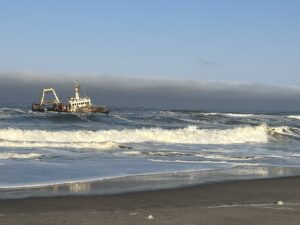
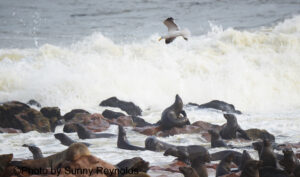
Etosha National Park is another must-see on any trip to Namibia. In the Oshiwambo language, the name “Etosha” means “great white place” due to the large salt pan that covers 1,900 square miles of the park. The park is dotted by watering holes, giving visitors the perfect opportunity for wildlife sightings. Get ready for game drives to see giraffes, elephants, lions, leopards, rhinos, ostriches, herds of zebra and wildebeest, a variety of plains game and birds, and so much more.
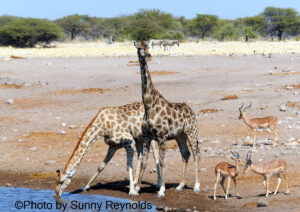
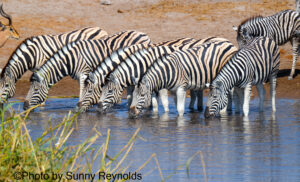
If you wish to experience sights and scenery that most have never experienced, join us this time next year in Namibia, July 26 – August 13. I promise you this is a place you won’t soon forget.
Click here for the full itinerary and all the details.
Contact us to reserve your spot for our 2024 trip today
By Alyssa Brown






